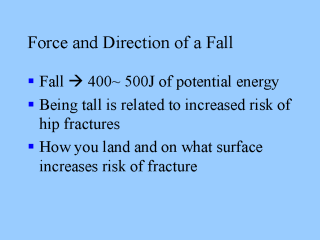| The force of a
fall plays a major role in determining whether a person will fracture or not. So how you
land will increase fracture risk. Falls
from standing height or higher have the average of 400 to 500 J of potential energy, which
is more than sufficient enough to break bones (King, 1996). The greater the distance of
the hip bone to the floor, the greater the risk of fracturing a hip when you fall. So Tall
people seems to have an increased risk of fractures when they fall (Nevitt. 1993).
The angle at which a person falls is
important. Falling sideways or straight down is more risky that falling backwards. By
grabbing an object when they fall, people can reduce the risk of fracture. Some researches
have suggested that hip padding can reduce the chances of fracturing a hip after a fall.
Because the energy created by the fall is distributed throughout the pad, lessening the
impact to the hip. |
